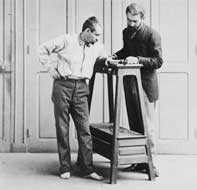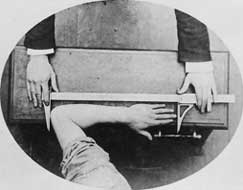The bertillonage (also known as anthropometry, or the Bertillon system), created in the 1880’s by Alphonse Bertillon, became the primary method for identifying criminals in the late 1800’s. Bertillon based his system on the claim that measurement of adult bones does not change after the age of 20. He also introduced a cataloguing system, which enabled filing/checking records faster.

 Measurement of the cubit (from the tip of the middle finger to the elbow)
Measurement of the cubit (from the tip of the middle finger to the elbow)
The system was used world-wide until 1903, when it was replaced by finger printing. The Bertillon system used multiple bodily measurements. A person would go through a 20-60 minute measuring exam where they would have 11 different body measurements taken: height, length, and breadth of the head, the idth of cheeks, the length of different fingers, the length of forearms, etc. The results were then recorded and/or compared to a record database. Everything was done by hand.
A few Bertillonage elements exist even today in the criminal police identification process, for example the combination of profile and frontal shots when photographing offenders.
More on the website of Visible Proofs, an exhibition about the history of forensic medicine. Images and background.
Via gmtplus9.
